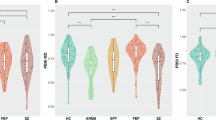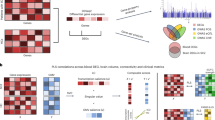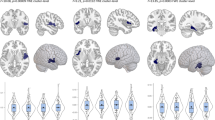Abstract
Schizophrenia is characterized with greater variability beyond the mean differences in brain structures. This variability is assumed to be static, reflecting the presence of heterogeneous subgroups, but this assumption and alternative explanations remain untested. Here we examine whether gray matter volume variability decreases in later stages of schizophrenia using magnetic resonance imaging of 1,792 individuals with schizophrenia and 1,523 healthy controls. Compared with healthy controls, greater variability (false-discovery-rate-corrected P < 0.05) was found in 50 regions across the entire patient group. The average variability across all regions was greater in the first-episode than chronic stage (t = 10.8, P = 1.7 × 10–7). The areas with the largest variability were located at the frontotemporal cortex and thalamus (first-episode), or the hippocampus and caudate (chronic). This study offers novel insights into the diversity of brain alterations in schizophrenia, emphasizing that brain-based heterogeneity is not a static feature; it is more pronounced at the onset of the disorder but reduced over the long term.
This is a preview of subscription content, access via your institution
Access options
Subscribe to this journal
Receive 12 digital issues and online access to articles
79,00 € per year
only 6,58 € per issue
Buy this article
- Purchase on SpringerLink
- Instant access to full article PDF
Prices may be subject to local taxes which are calculated during checkout




Similar content being viewed by others
Data availability
COBRE, NMorphCH, FBIRN and NUSDAST data were obtained from SchizConnect at https://www.nitrc.org/projects/schizconnect/. The COBRE dataset was download from the Center for Biomedical Research Excellence in Brain Function and Mental Illness (COBRE) at http://coins.mrn.org/. The NMorphCH dataset was download from https://nunda.northwestern.edu/nunda/data/projects/NMorphCH. The FBIRN dataset was downloaded from https://www.nitrc.org/projects/fbirn/. The NUSDAST dataset was download from the Northwestern University Schizophrenia Data and Software Tool. The DS000115 dataset was download from the OpenfMRI database at https://www.openfmri.org/. ENIGMA summary statistics of thinner cortical thickness map were obtained from the ENIGMA Toolbox at https://github.com/MICA-MNI/ENIGMA (v.2.0.0, July 2022; ref. 25). Gene expression data of brain tissue samples was obtained from the Allen Human Brain Atlas dataset (AHBA) at http://human.brain-map.org. All data needed to evaluate the conclusions in the paper are present in the paper and/or Supplementary Information.
Code availability
Brain images were processed by using FreeSurfer (v.7.3) (http://surfer.nmr.mgh.harvard.edu/; ref. 52). Gene enrichment analysis was performed using Metascape (v.3.5) (https://metascape.org). The visualization of brain mapping images was conducted using the ENIGMA Toolbox (v.2.0.0) (https://enigma-toolbox.readthedocs.io/en/latest/index.html). The code for spatial permutation test is available at https://github.com/frantisekvasa/rotate_parcellation.
References
Brugger, S. P. & Howes, O. D. Heterogeneity and homogeneity of regional brain structure in schizophrenia: a meta-analysis. JAMA Psychiatry 74, 1104–1111 (2017).
Wolfers, T. et al. Mapping the heterogeneous phenotype of schizophrenia and bipolar disorder using normative models. JAMA Psychiatry 75, 1146–1155 (2018).
Zhao, M. et al. An attention-based hybrid deep learning framework integrating brain connectivity and activity of resting-state functional MRI data. Med. Image Anal. 78, 102413 (2022).
Voineskos, A. N., Jacobs, G. R. & Ameis, S. H. Neuroimaging heterogeneity in psychosis: neurobiological underpinnings and opportunities for prognostic and therapeutic innovation. Biol. Psychiatry 88, 95–102 (2020).
Pan, Y. et al. Morphological profiling of schizophrenia: cluster analysis of MRI-based cortical thickness data. Schizophr. Bull. 46, 623–632 (2020).
Jiang, Y. et al. Neuroimaging biomarkers define neurophysiological subtypes with distinct trajectories in schizophrenia. Nat. Mental Health 1, 186–199 (2023).
Chen, D. et al. Neurophysiological stratification of major depressive disorder by distinct trajectories. Nat. Mental Health 1, 863–875 (2023).
Alnaes, D. et al. Brain heterogeneity in schizophrenia and its association with polygenic risk. JAMA Psychiatry 76, 739–748 (2019).
Sun, Y. H., Wu, Y.-L. & Liao, B.-Y. Phenotypic heterogeneity in human genetic diseases: ultrasensitivity-mediated threshold effects as a unifying molecular mechanism. J. Biomed. Sci. 30, 58 (2023).
Palaniyappan, L. Clusters of psychosis: compensation as a contributor to the heterogeneity of schizophrenia. J. Psychiatry Neurosci. 48, E325–E329 (2023).
Jiang, Y. et al. Progressive reduction in gray matter in patients with schizophrenia assessed with MR Imaging by using causal network analysis. Radiology 287, 633–642 (2018).
Haijma, S. V. et al. Brain volumes in schizophrenia: a meta-analysis in over 18000 subjects. Schizophr. Bull. 39, 1129–1138 (2013).
Jiang, Y. et al. Antipsychotics effects on network-level reconfiguration of cortical morphometry in first-episode schizophrenia. Schizophr. Bull. 48, 231–240 (2022).
Andreasen, N. C. et al. Progressive brain change in schizophrenia: a prospective longitudinal study of first-episode schizophrenia. Biol. Psychiatry 70, 672–679 (2011).
Olabi, B. et al. Are there progressive brain changes in schizophrenia? A meta-analysis of structural magnetic resonance imaging studies. Biol. Psychiatry 70, 88–96 (2011).
Wannan, C. M. J. et al. Evidence for network-based cortical thickness reductions in schizophrenia. Am. J. Psychiatry 176, 552–563 (2019).
Kim, D. I. et al. Identification of imaging biomarkers in schizophrenia: a coefficient-constrained independent component analysis of the mind multi-site schizophrenia study. Neuroinformatics 8, 213–229 (2010).
Shafiei, G. et al. Spatial patterning of tissue volume loss in schizophrenia reflects brain network architecture. Biol. Psychiatry 87, 727–735 (2020).
Lariviere, S. et al. Network-based atrophy modeling in the common epilepsies: a worldwide ENIGMA study. Sci. Adv. 6, eabc6457 (2020).
Shafiei, G. et al. Network structure and transcriptomic vulnerability shape atrophy in frontotemporal dementia. Brain 146, 321–336 (2023).
Zhou, J. et al. Predicting regional neurodegeneration from the healthy brain functional connectome. Neuron 73, 1216–1227 (2012).
Georgiadis, F. et al. Connectome architecture shapes large-scale cortical alterations in schizophrenia: a worldwide ENIGMA study. Mol. Psychiatry 29, 1869–1881 (2024).
Chopra, S. et al. Network-based spreading of gray matter changes across different stages of psychosis. JAMA Psychiatry 80, 1246–1257 (2023).
Raj, A., Kuceyeski, A. & Weiner, M. A network diffusion model of disease progression in dementia. Neuron 73, 1204–1215 (2012).
MICA-MNI/ENIGMA (GitHub, 2025); https://github.com/MICA-MNI/ENIGMA
Rantala, M. J. et al. Schizophrenia: the new etiological synthesis. Neurosci. Biobehav. Rev. 142, 104894 (2022).
Omlor, W. et al. Estimating multimodal brain variability in schizophrenia spectrum disorders: a worldwide ENIGMA study. Am. J. Psychiatry 182, 373–388 (2025).
Guo, S. et al. Dynamic cerebral reorganization in the pathophysiology of schizophrenia: a MRI-derived cortical thickness study. Psychol. Med. 46, 2201–2214 (2016).
Palaniyappan, L. et al. Structural covariance and cortical reorganisation in schizophrenia: a MRI-based morphometric study. Psychol. Med. 49, 412–420 (2019).
Feinberg, I. Schizophrenia: caused by a fault in programmed synaptic elimination during adolescence? J. Psychiatr. Res. 17, 319–334 (1982).
Keshavan, M. S., Anderson, S. & Pettegrew, J.W. Is schizophrenia due to excessive synaptic pruning in the prefrontal cortex? The Feinberg hypothesis revisited. J. Psychiatr. Res. 28, 239–265 1994).
Howes, O. D. & Onwordi, E. C. The synaptic hypothesis of schizophrenia version III: a master mechanism. Mol. Psychiatry 28, 1843–1856 (2023).
Howes, O. D., Bukala, B. R. & Beck, K. Schizophrenia: from neurochemistry to circuits, symptoms and treatments. Nat. Rev. Neurol. 20, 22–35 (2023).
Writing Committee for the Attention-Deficit/Hyperactivity, D. et al. Virtual histology of cortical thickness and shared neurobiology in 6 psychiatric disorders. JAMA Psychiatry 78, 47–63 (2021).
Swayze, V. W. et al. Developmental abnormalities of the corpus callosum in schizophrenia. Arch. Neurol. 47, 805–808 (1990).
Erdoğan, D.B. et al. in The Corpus Callosum: Embryology, Neuroanatomy, Neurophysiology, Neuropathology, and Surgery (eds. Turgut, M. et al.) 281–285 (Springer, 2023).
Friston, K. J. & Frith, C. D. Schizophrenia: a disconnection syndrome?. Clin. Neurosci. 3, 89–97 (1995).
Friston, K. J. Dysfunctional connectivity in schizophrenia. World Psychiatry 1, 66–71 (2002).
Provenzano, F. A. et al. Hippocampal pathology in clinical high-risk patients and the onset of schizophrenia. Biol. Psychiatry 87, 234–242 (2020).
Pines, A.R., et al. Mapping lesions that cause psychosis to a human brain circuit and proposed stimulation target. JAMA Psychiatry 82, 368–378 (2025).
Lieberman, J. A. et al. Hippocampal dysfunction in the pathophysiology of schizophrenia: a selective review and hypothesis for early detection and intervention. Mol. Psychiatry 23, 1764–1772 (2018).
Knight, S. et al. Hippocampal circuit dysfunction in psychosis. Transl. Psychiatry 12, 344 (2022).
McHugo, M. et al. Hippocampal volume in early psychosis: a 2-year longitudinal study. Transl. Psychiatry 10, 306 (2020).
Briend, F. et al. Hippocampal glutamate and hippocampus subfield volumes in antipsychotic-naive first episode psychosis subjects and relationships to duration of untreated psychosis. Transl. Psychiatry 10, 137 (2020).
Schobel, S. A. et al. Imaging patients with psychosis and a mouse model establishes a spreading pattern of hippocampal dysfunction and implicates glutamate as a driver. Neuron 78, 81–93 (2013).
Radhakrishnan, R. et al. In vivo evidence of lower synaptic vesicle density in schizophrenia. Mol. Psychiatry 26, 7690–7698 (2021).
Jiang, Y. et al. Neuroimaging epicenters as potential sites of onset of the neuroanatomical pathology in schizophrenia. Sci. Adv. 10, eadk6063 (2024).
Jiang, Y. et al. Neurostructural subgroup in 4291 individuals with schizophrenia identified using the subtype and stage inference algorithm. Nat. Commun. 15, 5996 (2024).
Jiang, Y. et al. Identification of four biotypes in temporal lobe epilepsy via machine learning on brain images. Nat. Commun. 15, 2221 (2024).
van Erp, T. G. M. et al. Cortical brain abnormalities in 4474 individuals with schizophrenia and 5098 control subjects via the Enhancing Neuro Imaging Genetics Through Meta Analysis (ENIGMA) Consortium. Biol. Psychiatry 84, 644–654 (2018).
van Erp, T. G. et al. Subcortical brain volume abnormalities in 2028 individuals with schizophrenia and 2540 healthy controls via the ENIGMA consortium. Mol. Psychiatry 21, 547–553 (2016).
FreeSurfer v.7.3 (Harvard Medical School, 2025); https://surfer.nmr.mgh.harvard.edu/
Desikan, R. S. et al. An automated labeling system for subdividing the human cerebral cortex on MRI scans into gyral based regions of interest. Neuroimage 31, 968–980 (2006).
Abdi, H. Partial least squares regression and projection on latent structure regression (PLS Regression). Wiley Interdiscip. Rev. Comput. Stat. 2, 97–106 (2010).
Zhou, Y. et al. Metascape provides a biologist-oriented resource for the analysis of systems-level datasets. Nat. Commun. 10, 1523 (2019).
Hansen, J. Y. et al. Mapping neurotransmitter systems to the structural and functional organization of the human neocortex. Nat. Neurosci. 25, 1569–1581 (2022).
Royer, J. et al. An open MRI dataset for multiscale neuroscience. Sci. Data 9, 569 (2022).
Acknowledgements
This work was supported by the grant from Science and Technology Innovation 2030-Brain Science and Brain-Inspired Intelligence Project (no. 2022ZD0212800 to Y.J.). This work was supported by National Natural Science Foundation of China (no. 82202242 to Y.J., no. 82071997 to W.C.). This work was supported by the projects from China Postdoctoral Science Foundation (no. BX2021078 and 2021M700852 to Y.J.). This work was supported by the Shanghai Rising-Star Program (no. 21QA1408700 to W.C.) and the Shanghai Sailing Program (grant no. 22YF1402800 to Y.J.) from Shanghai Science and Technology Committee. This work was supported by National Key R&D Program of China (grant no. 2019YFA0709502 to J.F.), the grant from Shanghai Municipal Science and Technology Major Project (grant no. 2018SHZDZX01 to J.F.), ZJ Laboratory, and Shanghai Center for Brain Science and Brain-Inspired Technology, and the grant from the 111 Project (grant no. B18015 to J.F.). This work was supported by grants from the National Key R&D Program of China (grant no. 2022ZD0208500 to D.Y.), Natural Science Basic Research Program of Shaanxi (grant no. 2025SYS-SYSZD-061 to L.-B.C.) and the CAMS Innovation Fund for Medical Sciences (grant no. 2019-I2M-5-039 to C.L.). L.P. acknowledges research support from the Canada First Research Excellence Fund, awarded to the Healthy Brains, Healthy Lives initiative at McGill University (through New Investigator Supplement to L.P.); Monique H. Bourgeois Chair in Developmental Disorders and Graham Boeckh Foundation (Douglas Research Centre, McGill University) and a salary award from the Fonds de recherche du Quebec-Santé (FRQS nos. 366934 and 313133).
Author information
Authors and Affiliations
Contributions
Y.J. and J.F. conceptualized and designed the project. J.Z., E.Z., X.Y., S.-J.T., C.-P.L., J.C., Y.T., J.W., C.L., D.Y. and L.-B.C. acquired the data. Y.J. and X.C. analyzed and interpreted the data. Y.J. & L.P. drafted the original paper. L.P., X.C. and W.C. critically reviewed the paper for important intellectual content. Y.J. and X.C. performed the statistical analysis. J.F. supervised the project.
Corresponding author
Ethics declarations
Competing interests
L.P. reports personal fees for serving as Chief Editor from the Canadian Medical Association Journals; a speaker and consultancy fee from Janssen Canada and Otsuka Canada, SPMM Course Limited, UK, Canadian Psychiatric Association; book royalties from Oxford University Press; and investigator-initiated educational grants from Janssen Canada, Sunovion and Otsuka Canada outside of the submitted work. The other authors declare no competing interests.
Peer review
Peer review information
Nature Mental Health thanks the anonymous reviewer(s) for their contribution to the peer review of this work.
Additional information
Publisher’s note Springer Nature remains neutral with regard to jurisdictional claims in published maps and institutional affiliations.
Extended Data
Extended Data Fig. 1 High consistency between the case–control difference (that is, effect size).
(a) discovery sample (n = 1,792). (b) validation sample (n = 4,474). (c) It shows a highly spatial correlation (r = 0.678, p = 2.7×10-12) between discovery data and validation data. Spearman correlation test is used for data analysis in figure c.
Extended Data Fig. 2 Partial least squares (PLS) correlation analysis between individual deviation and human brain gene expression data.
(a) Spatial map of the first component (PLS1) in the left hemisphere. (b) The spatial correlation between the PLS1 score and individual deviation in schizophrenia, measured by PD- score. (c) The ranked gene weights of PLS1 (FDR p < 0.05). (d) Top 20 gene ontology (GO) biological processes by enrichment analysis. Circle color: different biological processes. Circle size: number of genes. (e) Gene enrichment analysis in Cell Type Signatures. (f) Gene enrichment analysis in human disease-associated database. Partial least squares correlation analysis is used for data analysis in figure b. Gene enrichment analysis is used for data analysis in figures e and f. Benjamini–Hochberg procedure is used for multiple comparisons adjustments.
Extended Data Fig. 3 Performance of network diffusion model (NDM) on estimating cross-sectional GMV differences in group-level patients with schizophrenia.
(a) Model performance is indexed by the Spearman correlation coefficient (r value) between observed values and estimated values across brain regions. (b) Model performance with each bilateral region as the source seed of NDM. The r values are mapped to a brain template to show model performance of each region being the NDM seed. Red stars represent the optimal seed region (bilateral) with best performance. NDMMC, morphological covariance connectome type-based NDM; NDMSC, structural connectome type-based NDM; NDMFC, functional connectome type-based NDM.
Supplementary information
Supplementary Information
Supplementary Methods 1–5, Results 1–7, Discussion and Tables 1–11.
Rights and permissions
Springer Nature or its licensor (e.g. a society or other partner) holds exclusive rights to this article under a publishing agreement with the author(s) or other rightsholder(s); author self-archiving of the accepted manuscript version of this article is solely governed by the terms of such publishing agreement and applicable law.
About this article
Cite this article
Jiang, Y., Palaniyappan, L., Chang, X. et al. Gray matter volume heterogeneity by stage, site of origin and pathophysiology in schizophrenia. Nat. Mental Health (2025). https://doi.org/10.1038/s44220-025-00449-9
Received:
Accepted:
Published:
DOI: https://doi.org/10.1038/s44220-025-00449-9



